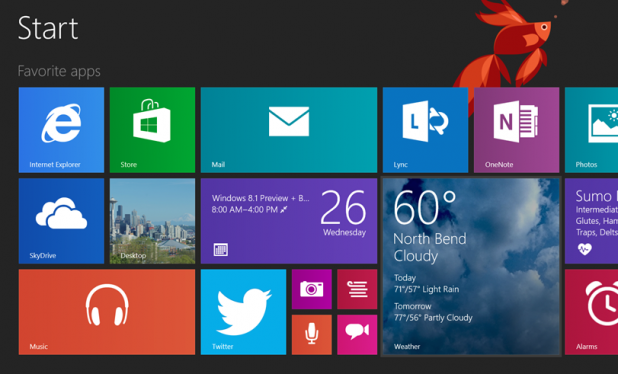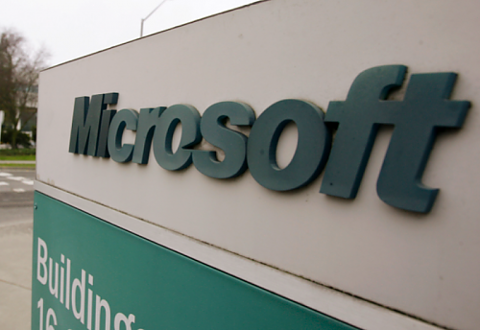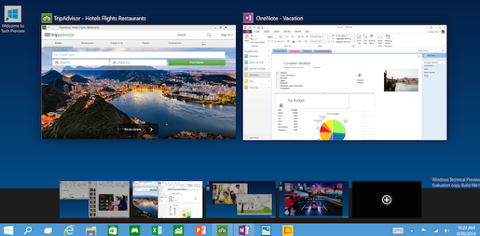 Windows 8.1.[/caption] After months of hinting about the next big Windows upgrade, Microsoft used the first day of its BUILD developer conference in San Francisco to whip the curtain back from Windows 8.1 (also known as “Windows Blue”). Windows 8.1 includes a number of tweaks and adjustments. The Start screen now offers three sizes of tile, giving users a bit more variety—larger tiles can display more dynamic information, such as weather. Microsoft is also drawing its other properties more tightly into Windows 8, offering Bing-branded search results that draw not only from the Web, but the user’s apps, files, and SkyDrive. Nor is that the only integration: users can answer Skype calls from their lock screen. The built-in Windows Store has been redesigned for easier access to apps; Windows 8.1 comes with Internet Explorer 11 (E11), which has been optimized for touch. The new-and-improved Mail app features drag-and-drop and other abilities. Microsoft executives drew cheers at BUILD when they announced that Windows 8.1 would reintroduce the Start button, a longtime feature deleted from Windows 8. If that restoration was a bone thrown to the users who liked Windows’ old ways, a lot of other tweaks pushed Windows 8.1 even further into new territory. Windows 8’s ability to “snap” applications together on the same screen has been expanded—in addition to snapping two applications side-by-side, users can have multiple apps coexisting on the same screen (the limits of this ability hinge on the number of pixels in play). And in many cases, those pixels will be limited: Microsoft is pushing Windows 8.1 onto 7- and 8-inch tablets. The company has little choice: rivals such as Apple, Google, and Amazon have all profited greatly from consumer interest in “mini tablets.” Therein lies the rub: the iPad Mini, the Kindle Fire, and the Nexus 7 have already established audiences, making it that much harder for a “mini Windows” tablet to make a quick and decisive showing on the open market. After years of dominating every segment of the “traditional” PC market, from cheap netbooks all the way up to hardcore gaming desktops, it must be a point of particular frustration for Microsoft executives that Windows needs to fight uphill—metaphorically speaking, of course—in order to carve off even a sliver of the tablet market, much less dominate touch-screens from minis all the way up to oversized hybrids. It’s possible that Windows 8.1 could be a significant step in that direction—but it’s still a huge hill ahead. Image: Microsoft
Windows 8.1.[/caption] After months of hinting about the next big Windows upgrade, Microsoft used the first day of its BUILD developer conference in San Francisco to whip the curtain back from Windows 8.1 (also known as “Windows Blue”). Windows 8.1 includes a number of tweaks and adjustments. The Start screen now offers three sizes of tile, giving users a bit more variety—larger tiles can display more dynamic information, such as weather. Microsoft is also drawing its other properties more tightly into Windows 8, offering Bing-branded search results that draw not only from the Web, but the user’s apps, files, and SkyDrive. Nor is that the only integration: users can answer Skype calls from their lock screen. The built-in Windows Store has been redesigned for easier access to apps; Windows 8.1 comes with Internet Explorer 11 (E11), which has been optimized for touch. The new-and-improved Mail app features drag-and-drop and other abilities. Microsoft executives drew cheers at BUILD when they announced that Windows 8.1 would reintroduce the Start button, a longtime feature deleted from Windows 8. If that restoration was a bone thrown to the users who liked Windows’ old ways, a lot of other tweaks pushed Windows 8.1 even further into new territory. Windows 8’s ability to “snap” applications together on the same screen has been expanded—in addition to snapping two applications side-by-side, users can have multiple apps coexisting on the same screen (the limits of this ability hinge on the number of pixels in play). And in many cases, those pixels will be limited: Microsoft is pushing Windows 8.1 onto 7- and 8-inch tablets. The company has little choice: rivals such as Apple, Google, and Amazon have all profited greatly from consumer interest in “mini tablets.” Therein lies the rub: the iPad Mini, the Kindle Fire, and the Nexus 7 have already established audiences, making it that much harder for a “mini Windows” tablet to make a quick and decisive showing on the open market. After years of dominating every segment of the “traditional” PC market, from cheap netbooks all the way up to hardcore gaming desktops, it must be a point of particular frustration for Microsoft executives that Windows needs to fight uphill—metaphorically speaking, of course—in order to carve off even a sliver of the tablet market, much less dominate touch-screens from minis all the way up to oversized hybrids. It’s possible that Windows 8.1 could be a significant step in that direction—but it’s still a huge hill ahead. Image: Microsoft At BUILD, Microsoft Unveils More of Windows 8.1
[caption id="attachment_10654" align="aligncenter" width="618"]  Windows 8.1.[/caption] After months of hinting about the next big Windows upgrade, Microsoft used the first day of its BUILD developer conference in San Francisco to whip the curtain back from Windows 8.1 (also known as “Windows Blue”). Windows 8.1 includes a number of tweaks and adjustments. The Start screen now offers three sizes of tile, giving users a bit more variety—larger tiles can display more dynamic information, such as weather. Microsoft is also drawing its other properties more tightly into Windows 8, offering Bing-branded search results that draw not only from the Web, but the user’s apps, files, and SkyDrive. Nor is that the only integration: users can answer Skype calls from their lock screen. The built-in Windows Store has been redesigned for easier access to apps; Windows 8.1 comes with Internet Explorer 11 (E11), which has been optimized for touch. The new-and-improved Mail app features drag-and-drop and other abilities. Microsoft executives drew cheers at BUILD when they announced that Windows 8.1 would reintroduce the Start button, a longtime feature deleted from Windows 8. If that restoration was a bone thrown to the users who liked Windows’ old ways, a lot of other tweaks pushed Windows 8.1 even further into new territory. Windows 8’s ability to “snap” applications together on the same screen has been expanded—in addition to snapping two applications side-by-side, users can have multiple apps coexisting on the same screen (the limits of this ability hinge on the number of pixels in play). And in many cases, those pixels will be limited: Microsoft is pushing Windows 8.1 onto 7- and 8-inch tablets. The company has little choice: rivals such as Apple, Google, and Amazon have all profited greatly from consumer interest in “mini tablets.” Therein lies the rub: the iPad Mini, the Kindle Fire, and the Nexus 7 have already established audiences, making it that much harder for a “mini Windows” tablet to make a quick and decisive showing on the open market. After years of dominating every segment of the “traditional” PC market, from cheap netbooks all the way up to hardcore gaming desktops, it must be a point of particular frustration for Microsoft executives that Windows needs to fight uphill—metaphorically speaking, of course—in order to carve off even a sliver of the tablet market, much less dominate touch-screens from minis all the way up to oversized hybrids. It’s possible that Windows 8.1 could be a significant step in that direction—but it’s still a huge hill ahead. Image: Microsoft
Windows 8.1.[/caption] After months of hinting about the next big Windows upgrade, Microsoft used the first day of its BUILD developer conference in San Francisco to whip the curtain back from Windows 8.1 (also known as “Windows Blue”). Windows 8.1 includes a number of tweaks and adjustments. The Start screen now offers three sizes of tile, giving users a bit more variety—larger tiles can display more dynamic information, such as weather. Microsoft is also drawing its other properties more tightly into Windows 8, offering Bing-branded search results that draw not only from the Web, but the user’s apps, files, and SkyDrive. Nor is that the only integration: users can answer Skype calls from their lock screen. The built-in Windows Store has been redesigned for easier access to apps; Windows 8.1 comes with Internet Explorer 11 (E11), which has been optimized for touch. The new-and-improved Mail app features drag-and-drop and other abilities. Microsoft executives drew cheers at BUILD when they announced that Windows 8.1 would reintroduce the Start button, a longtime feature deleted from Windows 8. If that restoration was a bone thrown to the users who liked Windows’ old ways, a lot of other tweaks pushed Windows 8.1 even further into new territory. Windows 8’s ability to “snap” applications together on the same screen has been expanded—in addition to snapping two applications side-by-side, users can have multiple apps coexisting on the same screen (the limits of this ability hinge on the number of pixels in play). And in many cases, those pixels will be limited: Microsoft is pushing Windows 8.1 onto 7- and 8-inch tablets. The company has little choice: rivals such as Apple, Google, and Amazon have all profited greatly from consumer interest in “mini tablets.” Therein lies the rub: the iPad Mini, the Kindle Fire, and the Nexus 7 have already established audiences, making it that much harder for a “mini Windows” tablet to make a quick and decisive showing on the open market. After years of dominating every segment of the “traditional” PC market, from cheap netbooks all the way up to hardcore gaming desktops, it must be a point of particular frustration for Microsoft executives that Windows needs to fight uphill—metaphorically speaking, of course—in order to carve off even a sliver of the tablet market, much less dominate touch-screens from minis all the way up to oversized hybrids. It’s possible that Windows 8.1 could be a significant step in that direction—but it’s still a huge hill ahead. Image: Microsoft
 Windows 8.1.[/caption] After months of hinting about the next big Windows upgrade, Microsoft used the first day of its BUILD developer conference in San Francisco to whip the curtain back from Windows 8.1 (also known as “Windows Blue”). Windows 8.1 includes a number of tweaks and adjustments. The Start screen now offers three sizes of tile, giving users a bit more variety—larger tiles can display more dynamic information, such as weather. Microsoft is also drawing its other properties more tightly into Windows 8, offering Bing-branded search results that draw not only from the Web, but the user’s apps, files, and SkyDrive. Nor is that the only integration: users can answer Skype calls from their lock screen. The built-in Windows Store has been redesigned for easier access to apps; Windows 8.1 comes with Internet Explorer 11 (E11), which has been optimized for touch. The new-and-improved Mail app features drag-and-drop and other abilities. Microsoft executives drew cheers at BUILD when they announced that Windows 8.1 would reintroduce the Start button, a longtime feature deleted from Windows 8. If that restoration was a bone thrown to the users who liked Windows’ old ways, a lot of other tweaks pushed Windows 8.1 even further into new territory. Windows 8’s ability to “snap” applications together on the same screen has been expanded—in addition to snapping two applications side-by-side, users can have multiple apps coexisting on the same screen (the limits of this ability hinge on the number of pixels in play). And in many cases, those pixels will be limited: Microsoft is pushing Windows 8.1 onto 7- and 8-inch tablets. The company has little choice: rivals such as Apple, Google, and Amazon have all profited greatly from consumer interest in “mini tablets.” Therein lies the rub: the iPad Mini, the Kindle Fire, and the Nexus 7 have already established audiences, making it that much harder for a “mini Windows” tablet to make a quick and decisive showing on the open market. After years of dominating every segment of the “traditional” PC market, from cheap netbooks all the way up to hardcore gaming desktops, it must be a point of particular frustration for Microsoft executives that Windows needs to fight uphill—metaphorically speaking, of course—in order to carve off even a sliver of the tablet market, much less dominate touch-screens from minis all the way up to oversized hybrids. It’s possible that Windows 8.1 could be a significant step in that direction—but it’s still a huge hill ahead. Image: Microsoft
Windows 8.1.[/caption] After months of hinting about the next big Windows upgrade, Microsoft used the first day of its BUILD developer conference in San Francisco to whip the curtain back from Windows 8.1 (also known as “Windows Blue”). Windows 8.1 includes a number of tweaks and adjustments. The Start screen now offers three sizes of tile, giving users a bit more variety—larger tiles can display more dynamic information, such as weather. Microsoft is also drawing its other properties more tightly into Windows 8, offering Bing-branded search results that draw not only from the Web, but the user’s apps, files, and SkyDrive. Nor is that the only integration: users can answer Skype calls from their lock screen. The built-in Windows Store has been redesigned for easier access to apps; Windows 8.1 comes with Internet Explorer 11 (E11), which has been optimized for touch. The new-and-improved Mail app features drag-and-drop and other abilities. Microsoft executives drew cheers at BUILD when they announced that Windows 8.1 would reintroduce the Start button, a longtime feature deleted from Windows 8. If that restoration was a bone thrown to the users who liked Windows’ old ways, a lot of other tweaks pushed Windows 8.1 even further into new territory. Windows 8’s ability to “snap” applications together on the same screen has been expanded—in addition to snapping two applications side-by-side, users can have multiple apps coexisting on the same screen (the limits of this ability hinge on the number of pixels in play). And in many cases, those pixels will be limited: Microsoft is pushing Windows 8.1 onto 7- and 8-inch tablets. The company has little choice: rivals such as Apple, Google, and Amazon have all profited greatly from consumer interest in “mini tablets.” Therein lies the rub: the iPad Mini, the Kindle Fire, and the Nexus 7 have already established audiences, making it that much harder for a “mini Windows” tablet to make a quick and decisive showing on the open market. After years of dominating every segment of the “traditional” PC market, from cheap netbooks all the way up to hardcore gaming desktops, it must be a point of particular frustration for Microsoft executives that Windows needs to fight uphill—metaphorically speaking, of course—in order to carve off even a sliver of the tablet market, much less dominate touch-screens from minis all the way up to oversized hybrids. It’s possible that Windows 8.1 could be a significant step in that direction—but it’s still a huge hill ahead. Image: Microsoft 
